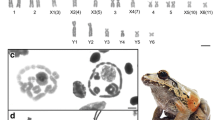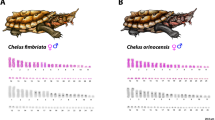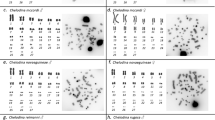Abstract
All 3 extant genera of monotremes show a unique kind of cytogenetic system involving the formation of a structurally heterozygous chain multiple apparently coupled with a system of complementary gametic elimination. In the echidna Tachyglossus there are 63 chromosomes in the male and 64 in the female. This is associated with an X1X2Y♂/X1X1X2X2♀ sex chromosome system. Additionally in both sexes there are 6 mitotic chromosomes (a-f) which have no obvious homologous partners. At male meiosis these are included with the 3 sex chromosomes in a chain multiple of nine which has the constitution X1·Y·X2·f·e·d·c·b·a. This shows convergent orientation at first metaphase leading to the production of two kinds of sperm, namely X1X2 eca and Yfdb. Since no individual of either sex has been found homozygous for any of the a-f elements it follows that only gametes carrying different combinations of the three unpaired elements give rise to viable offspring. Whether this depends on gametic selection or on zygotic lethality is not known. An apparently identical system operates in Zaglossus. In the platypus Ornithorhynchus, on the other hand, there are 52 chromosomes in both males and females associated with an XY♂/XX♀ sex chromosome mechanism and the presence of 4 consistently unpaired elements (a-d) at mitosis. A chain multiple of 10 forms at male meiosis involving the 2 sex chromosomes, the 4 unpaired elements and two of the small pairs of autosomes. Additionally the six longest autosome pairs in Tachyglossus and the X1 show a polymorphism for size which in heterozygous combination leads to the formation of unequal bivalents at male meiosis.
Similar content being viewed by others
References
Bick, Y.A.E., Jackson, W.D.: A mammalian X-O sex-chromosome system in the monotreme Tachyglossus aculeatus determined from leucocyte cultures and testicular preparations. Amer. Naturalist 101, 79–86 (1967a)
Bick, Y.A.E., Jackson, W.D.: Karyotype of the monotremes Ornithorhynchus anatinus (platypus) and Tachyglossus aculeatus (echidna). Nature (Lond.) 214, 600–601 (1967b)
Bick, Y.A.E., Murtagh, C.E., Sharman, G.B.: The chromosomes of an egg-laying mammal, Tachyglossus aculeatus (the echidna). Cytobios 7, 233–243 (1973)
Bick, Y.A.E., Sharman, G.B.: The chromosomes of the platypus (Ornithorhynchus: Monotremata). Cytobios 14, 17–28 (1975)
Bougourd, S.M., Parker, J.S.: Nucleolar-organiser polymorphism in natural populations of Allium schoenoprasum. Chromosoma (Berl.) 56, 301–307 (1976)
Brink, J.M. van: L'expression morphologique de la digamétie chez les Sauropsides et les Monotremes. Chromosoma (Berl.) 10, 1–72 (1959)
Burrell, H.: The platypus, chapter XI. Angus and Robertson 1927
Cleland, R.E.: The cytogenetics of Oenothera. Advanc Genet. 2. New York-London: Academic Press 1962
Cooper, D.W., Johnston, P.G., Sharman, G.B., VandeBerg, J.L.: The control of gene activity on eutherian and metatherian X chromosomes: A comparison. In: Reproduction and evolution. Proc. Fourth Int. Symp. of Comp. Biol. of Reproduction, pp. 81–87. Canberra: Australian Academy of Science 1977
Cooper, D.W., VandeBerg, J.L., Griffiths, M.E., Ealey, E.H.M.: Haemoglobin polymorphisms in the echidna, Tachyglossus aculeatus. Aust. J. biol. Sci. 26, 605–612 (1973)
Dutrillaux, B.: Study of human X-chromosomes with the 5 BrdU-acridine orange technique. Application to X chromosome pathology. Chromosomes today 5, 395–407 (1976)
Flynn, T.T., Hill, J.P.: The development of the monotremata. Part IV. Growth of the ovarian ovum, maturation, fertilisation, and early cleavage. Trans. Zool. Soc. Lond. 24, Part 6 (1939)
Griffiths, M.E.: Echidnas. Oxford: Pergamon Press 1968
Gropp, A., Giers, D., Kolbus, U.: Trisomy in the fetal backcross progeny of male and female metacentric heterozygotes of the mouse. I. Cytogenet. Cell Genet. 13, 511–535 (1974)
Hill, J.P., Gatenby, J.B.: The corpus luteum of the Monotremata. Proc. Zool. Soc. Lond. 1926, 715–763
Hopson, J.A.: The classification of non-therian mammals. J. Mamm. 51, 1–9 (1970)
Hopson, J.A., Crompton, A.W.: Origin of Mammals. Evol. Biol. 3, 15–72 (1969)
Iredale, T., Troughton, E. Le G.: A checklist of the mammals recorded from Australia. Mem. Aust. Mus. No. 6, (1934)
Kermack, K.A., Kielan-Jaworowska, S.: Therian and non-therian mammals. In: Early mammals (Kermack, D.M., and K.A. Kermack, eds.) pp. 103–115. London: Academic Press 1971
Kint, J.A.: The enzyme defect in Fabry's disease. Nature (Lond.) 227, 1173 (1970)
Lewontin, R.C.: The genetic basis of evolutionary change. New York-London: Columbia University Press 1974
Meera Khan, P., Westerveld, A., Wurzen-Figurelli, E.M., Bootsma, D.: α-galactosidase in manchinese hamster somatic cell hybrids. Cytogenet. Cell Genet. 14, 375–380 (1975)
Noda, S.: A new typed nucleolar chromosome and a supernumerary fragment chromosome in Allium cepa L. Mem. Fac. Science, Kyushu University, E. 1, 139–146 (1953)
Ogawa, K.: Chromosome studies in the Myriapoda. VII. A chain association of the multiple sex-chromosomes found in Otocryptops sexspinosus (Say). Cytologia (Tokyo) 19, 265–272 (1954)
Pathak, S., Hsu, T.C., Arrighi, F.E.: Chromosomes of Peromyscus (Rodentia, Cricetidae). IV. The role of heterochromatin in karyotypic evolution. Cytogenet. Cell Genet. 12, 315–326 (1973)
Rebourat, R., Weil, D., Van Cong, N., Frezal, J.: α-galactosidase: a dimeric enzyme dependent on a structural locus on the X-chromosome. Cytogenet. Cell Genet. 14, 406–408 (1975)
Sharman, G.B., Johnston, P.G.: X chromosome inactivation in kangaroos (Marsupialia). In: Reproduction and evolution. Proc. Fourth Int. Symp. comp. Biol. of Reproduction, pp. 67–68. Canberra: Australian Academy of Science 1977
Sutton, H.E.: An introduction to human genetics, 2nd ed., chapter 4. New York: Holt, Rinehart and Winston 1975
VandeBerg, J.L.: Ph. D. Thesis, Macquarie University (1975)
Walker, E.P.: Mammals of the World, 2nd edit, vol 1, pp. 1–9 Baltimore: Johns Hopkins Press 1968
White, M.J.D.: Animal cytology and evolution, 3rd ed., chap. 9. Cambridge: Cambridge University Press 1973
Whittaker, R.G., Thompson, E.O.P.: Studies on monotreme proteins. V. Amino acid sequence of the α-chain of haemoglobin from the platypus, Ornithorhynchus anatinus. Aust. J. biol. Sci. 27, 591–605 (1974)
Wiens, D., Barlow, B.A.: Permanent translocation heterozygosity and sex determination in East African mistletoes. Science 187, 1208–1209 (1975)
Woodburne, M.O., Tedford, R.H.: The first Tertiary monotreme from Australia. Amer. Mus. Novit. 2588, 1–11 (1975)
Author information
Authors and Affiliations
Rights and permissions
About this article
Cite this article
Murtagh, C.E. A unique cytogenetic system in monotremes. Chromosoma 65, 37–57 (1977). https://doi.org/10.1007/BF00293129
Received:
Accepted:
Issue Date:
DOI: https://doi.org/10.1007/BF00293129




